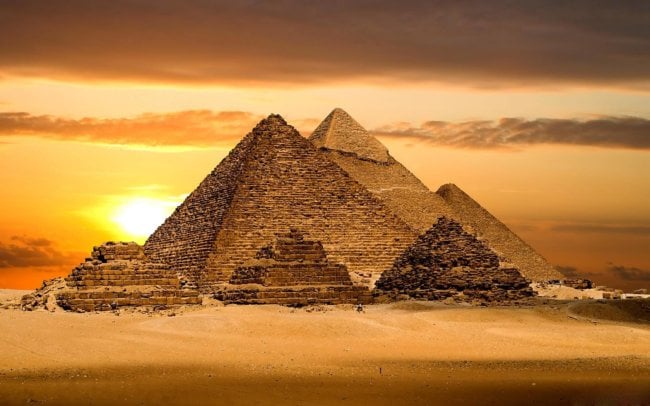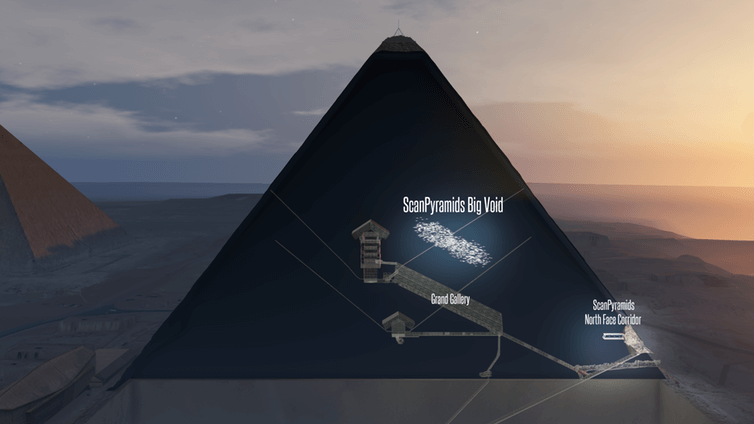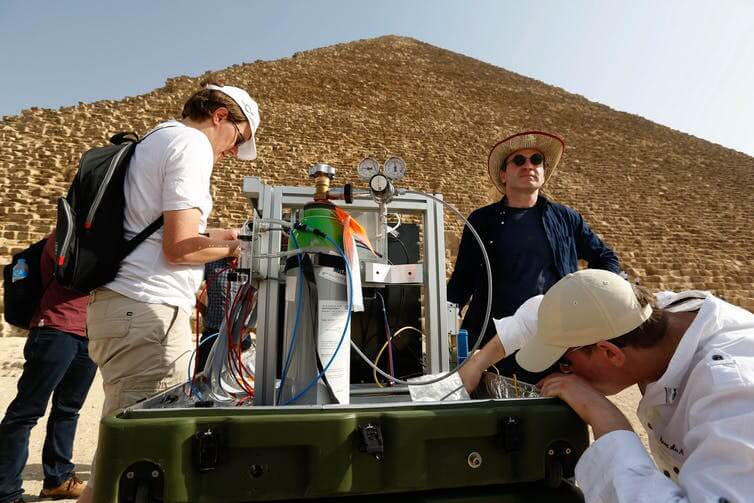
Particle physics found a large, hidden hole in the pyramid of Khufu, the largest pyramid at Giza, Egypt was built between 2600 and 2500 BC. The discovery, which was written in Nature, was made using imaging based on cosmic rays and could help scientists figure out how to actually built the mysterious pyramid.
At the heart of their technology is the tracking of particles called muons. They are very similar to electrons with the same charge and a quantum property called spin but 207 times heavier. This difference in mass is very important as it determines how these particles react when faced with matter.
High-energy electrons emit electromagnetic radiation, such as x-rays, when faced with the solid — as a result, lose energy and get stuck in it. Since the muon mass is much higher, the emission of electromagnetic radiation is suppressed to 207 times as compared with electrons. So muons do not stop so quickly when faced with any substance — they pierce right through him.
Muons are usually born in cosmic rays. The upper atmosphere of the Earth is continuously bombarded with charged particles from the sun and other sources outside our Solar system. It provides a high-energy cosmic rays that generate the muons and other particles in the chain reactions.

Since muons have a relatively large life span and relatively stable, they represent the most numerous particles in cosmic rays, visible at ground level. And while on the way lost a lot of energy, sometimes we see muons with a very high rate.
Muons in the service of science
To detect these particles is quite easy. They leave a subtle mark “ionization” in its way — that is, knock out electrons from atoms, leaving the atoms charged. It is very convenient: scientists can use multiple detectors to track the path of the muon to the source of its origin. Moreover, if the path of the muon will be a lot of substance, it can lose all energy to get stuck in the material and to decompose (split up into other particles) before the direct detection.
These properties make muon a good candidate for capturing objects that generally is impervious or opaque to our usual methods of observation. Just as the bones leave a shadow on photographic film exposed to x-rays, heavy and dense object with high atomic number will provide shade, or reduce the number of muons that can pass through this object.
The first muons were used in this way in 1955, when E. P. George measured the overburden of rocks above the tunnel, comparing the flux of muons on the outside and inside. The first known attempt to create a “myogram” took place in 1970, when Luis Alvarez was looking for the extended cavity of the second pyramid of Giza, but did not find one.
Over the last decade muon tomography has found a second wind. In 2007, the Japanese did myogram the crater of the volcano Asama to explore its internal structure.
Muon scans have also been used for the study of the remains of the reactor at Fukushima.
Exploring Khufu
The simplest way to explore a large object like the pyramid using muons to look at the differences in the flow of muons passing through it. Solid pyramid will leave a shadow or reduce the number of muons passing through it. If the pyramid will be a big void, the muon flux will increase in the course of this emptiness. The greater the difference between “solid” and “hollow”, so it is easier to find.
All you need is to sit somewhere nearby, to look a little upwards from the horizon to the pyramid and count the number of muons coming from all directions. Since cosmic muons have to be energetic to pass through a pyramid, and since our “eye” is relatively small, we have to sit and count some time, usually a few months to have enough muons. Just as we use two eyes make three-dimensional picture of the world in your head, we need two separate detector is the”eye” to get the three-dimensional image of the void inside the pyramid.

Interesting in the approach of this team that they chose three different technologies detectors for the study of the pyramid. The first of these somewhat old-fashioned but offers a higher resolution of the resulting images: photographic plates, which were blackened from ionization. Left them for a few months inside one of the famous chambers of the pyramid and analyzed in Japan after data collection.
For the second method used a plastic “scintillators”, which produce a light flash during the passage of a charged particle through them. These types of detectors are used in several modern neutrino experiments.
Finally, the chamber filled with gas in which it is possible to control the ionization caused by charged particles, was used to directly view the newly discovered void.

The electronic signal from these detectors is transmitted directly to Paris on 3G. Of course, the famous pyramid with three cavities and a giant empty gallery inside — quite difficult to myogram (it shows only black and white). So often these images compare with the computer simulation of cosmic muons and studied the pyramid, in parallel. Careful analysis of pictures of all three detectors and computer models have revealed a 30-foot void that was unknown until now, in the great pyramid of Giza. A striking success for the new tools.
Now this method can help us to study the detailed shape of this emptiness. Although we don’t know anything about the role of this structure, research projects involving scientists from other disciplines can be based on a new study. Nice to see how the ultra-modern particle physics helps us to shed light on ancient human culture.
Physics found in the great pyramid mysterious structure: how?
Ilya Hel